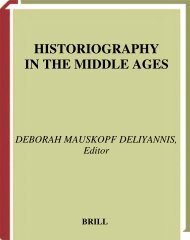Medieval Sexuality: A Casebook - Julian Emperor
Medieval Sexuality: A Casebook - Julian Emperor
Medieval Sexuality: A Casebook - Julian Emperor
Create successful ePaper yourself
Turn your PDF publications into a flip-book with our unique Google optimized e-Paper software.
2 April Harper and Caroline Proctorand queers.” Increasing numbers of conferences are being held, and books andarticles produced, devoted solely to the subject of sexuality. We were incrediblyfortunate to be given an excellent venue for our conference at St Andrews andenjoyed the great encouragement and support of the Department of <strong>Medieval</strong>History there, but Bullough’s lone session at the AHA was never far from ourminds, for though our conference was occasionally standing-room only as well,we were aware of the struggles we and our colleagues can still face in our field.One delegate informed us that the poster, which had been sent to her particularinstitution for posting, had, instead, been sent to her directly. Her reputation as amember of the dirty circle of historians of sexuality was obviously known and itwas assumed that only she would be interested in such a gathering. Experienceslike this made us keenly aware of our position as a third generation of historiansof sexuality, both in the continuing challenges we face, but much more so in thefreedom we now enjoy. It is the hard work of those like Bullough and Brundagein the first generation and the determination of the dozens of scholars who tookup the call as a second generation to push open the doors of conferences, publishinghouses and university curriculum committees that has made it possible for a thirdgeneration of scholars, including ourselves, to hold such conferences, to teachcourses on the theme of medieval sexuality and to identify ourselves as historiansof sexuality.In our title, we use the term “sexuality” deliberately. The conference thatinspired our collection was entitled “Sex: <strong>Medieval</strong> Perspectives” to draw attentionto the fact that our focus was not exclusively masculinity, femininity, gender orthe study of different sexualities; we wanted to talk about sex. It is a word thatis so often deliberately avoided and one that we wanted to emphasize. We realized,however, that “sex” was just as erroneous as any other term we were beingpressured to use, for we were interested not only in the act but in how it wasperceived, its role in law, literature, societies, cultures and religions, how it shapedthe image of men, women, and their roles in society, how it determined thedefinitions of masculinity, femininity, gender, “normality” and “deviancy.” Wewanted to explore, as Ruth Mazo Karras has described it in <strong>Sexuality</strong> in <strong>Medieval</strong>Europe: Doing Unto Others, “the universe of meanings that people place on sexacts” (New York: Routledge, 2005, 5). <strong>Sexuality</strong> is culture; it is representativeof a culture’s religion, attitudes, taboos and experience. It is the cultural definitions,ideals and changes in attitudes across time, geographical distance, genre andculture with which this volume is most concerned, and thus we have chosen totitle our work <strong>Medieval</strong> <strong>Sexuality</strong> to reflect the breadth of our contributors’ work.There is a trend for authors to preface their work with an explanation of whythe study of sexuality is valid and important. It is a credit to Bullough, Brundage,Murray, Salisbury, Mazo Karras and so many others whose names have becomesynonymous with the field, and who so eloquently and successfully argued onbehalf of the history of sexuality, that we may now make the conscious decisionnot to begin our work with such a declaration, and can, instead, focus on what













